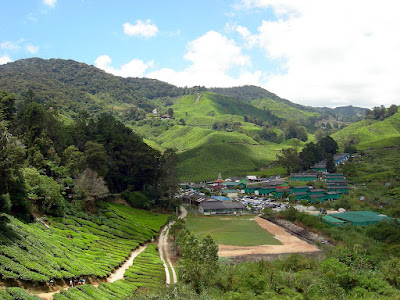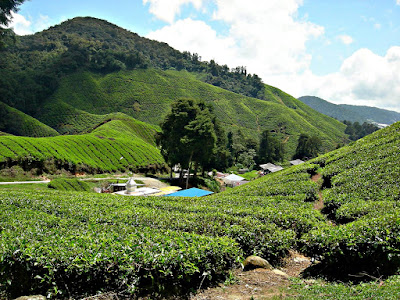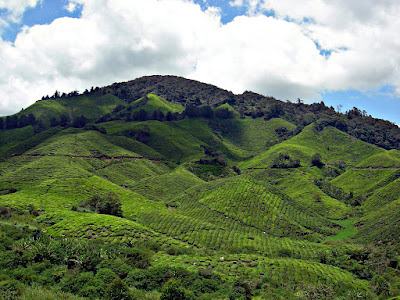Above: Billy Goat
We passed a few goats on the way to our next stop. This fellow was munching away on the grass on a hill.
Above: Three Billy Goats Gruff
A little further on were these kids. The same family perhaps?
Above: Information
At an altitude of 1500 metres above sea-level and covering around 235 hectares, the Sungei Palas tea factory is one of the most popular attractions with tourists and visitors. The air is clean and fresh and the grounds extensive.
Did you know?
Tea used to be plucked by hand as the workers move laboriously through the long rows of low tea bushes.
Today, the most common plucking method used is the two-man hand-held machine which is assisted by winches. These machines can harvest up to 300 kgs of green leaf per man per day, 10 times more than traditional hand plucking.
On the steepest slopes where access is limited, shears are used and can bring in about 120kgs per man per day.
After the harvest day is over, the leaf is first checked for quality, packed into sacks and weighed before being transported to the factory for processing.
The Manufacturing Process of Tea
We were taken on a tour of the factory and our guide explained the fascinating details of tea - from plant to packed in boxes for sale.
Harvesting
Tea bushes are harvested approximately every three weeks. The leaves are picked in the morning and immediately transported to the factory. Tea leaves are plucked only after two years from planting. Once the plant is mature, tea is plucked approximately every three weeks. The plucked leaves are checked for quality and are then transferred to the factory where they go through five main processing stages. Each stage brings out the distinctive fragrance and aroma from the tea leaves.
Withering
During this first step, the green leaf is withered to reduce moisture and allow natural chemical reactions to take place by putting them in troughs or bins with warm dry air running through them for about 12 to 20 hours. This is usually done overnight.
Rolling
The withered leaves are rolled to crush the leaf cells and process them into smaller particles. It also exposes the cells to oxygen. The rollers used at the factory date back to 1935.
Fermentation
Also known as oxidation, fermentation is the natural chemical process in which enzymes in the leaf are exposed to oxygen. This is the stage that determines the flavour, aroma and colour of the tea. The leaves are spread onto trays and the humidity, temperature and timing are carefully controlled. After fermentation, the tea leaves change from green to copper. This process takes from two to three hours.
Above: Drying the leaves
Drying
Drying stops the fermentation process and reduces the moisture in the leaf to 3%. The fermented leaf is fed into machines through which blasts of hot air heated to almost 120º Celsius is passed through the leaves.
The tea leaf then emerges into the familiar crisp black curled form we see and is known as "made tea." The process is completed in around 10 - 20 minutes. The furnace uses wood from the rubber trees to produce the hot air.
Sorting
After drying, the "made tea" is graded according to size. This is done by passing the leaves through several sieves known as vibroscreens. The fibres, stalks and off-grades are removed during this stage and each grade of tea has its own flavour, characteristics and density.
Tea Tasting
Tea tasting is a vital and essential part of the tea making process and is very specialised and requires years of training - like a wine taster. The taster examines each sample of dry tea leaves for texture, colour, amount of twist and evenness of grade. The infused leaves are then examined for colour, brightness and uniformity. Next, he or she tastes the tea for taste, flavour and aroma.
Above: A nice hot cup of tea
Storage
The tea is then stored in dry conditions to mature and mellow further before packing. It is important that to ensure there is no moisture as this would ruin the tea.
Packaging
The tea leaves are packaged into boxes and other containers and are now ready for the market.
Above: The five stages
The factory produces 600,000 kg of tea a year and has a variety of different brews - Pekoe, Cheeding, Palas Supreme, Cinnamon-flavoured. It is open Tuesday to Sunday from 9.00am to 4.30pm. Admission to the factory is free and tours are conducted every 30 minutes.
Above: Welcome sign
Above: Sungei Palas Tea Centre
The Sungei Palas Tea Centre is an airy and spacious complex housing a visitor gallery, tea shop, a cafe and museum.
History
During the British colonial ear in Malays, a Mr. J. Russel, a British businessman, started the BOH Plantations in 1929. Due to huge demands for tea coupled with the climate of the Cameron Highlands, he saw the potential and economic value and was granted a concession of land for his first tea garden in Habu.
Today, BOH Plantations has three tea gardens - Habu, (the first one), Fairlie and Sungei Palas Tea Garden. A packaging factory was set up neat the main garden - this ensured the freshness of their products. BOH tea products are distributed not only to the domestic market but also internationally.
Scenic Tea Gardens
Below are some shots I took of the beautiful gardens with their manicured rows
Above: BOH Tea
Above: Sungei Palas Gardens
Above: BOH Tea Plantation
Above: Tea plantation with coffee trees
Above: Sungei Palas Tea Plantation
Above: Restaurant exterior
Above: Friends
Sitting in the cafe drinking tea, the young man and his family were sitting next to me. We got to chatting - he taught me a few Malay phrases, and I told him a few Aussie slang words. His little sister was (I think) about eight or nine.
It was a lovely day and visiting the tea plantation was a real eye-opener - whoever would have thought there would be that much intensity involved in producing tea?
Malaysia Time
Click On Your Flag To Translate
Malaysia and Cambodia
Hello,
This is about my upcoming trip to Malaysia and Cambodia. The first part is pre-trip - information about flights, itineraries, accommodation and all the things that you need to do to plan an overseas holiday. This is my first trip to Asia and I hope it may help others. Comments are very welcome and anyone who has travelled to Malaysia and/or Cambodia, please feel free to comment and offer any advice or tips that you think would be helpful. As of today ( 28th February) , in exactly 11 days (minus 30 minutes) I will be in Kuala Lumpur.
Cheers.
I had the most amazing time and hope you enjoy reading about my trip. Each post is numbered and I'm doing them in order from start to finish - a little like a diary.
ANGKOR WAT SUNRISE
This is about my upcoming trip to Malaysia and Cambodia. The first part is pre-trip - information about flights, itineraries, accommodation and all the things that you need to do to plan an overseas holiday. This is my first trip to Asia and I hope it may help others. Comments are very welcome and anyone who has travelled to Malaysia and/or Cambodia, please feel free to comment and offer any advice or tips that you think would be helpful. As of today ( 28th February) , in exactly 11 days (minus 30 minutes) I will be in Kuala Lumpur.
Cheers.
I had the most amazing time and hope you enjoy reading about my trip. Each post is numbered and I'm doing them in order from start to finish - a little like a diary.
Saturday
Sunday
101. Mossy Forest
Above: Ginger plant
After seeing Mt. Brinchang, we walked a short way down the hill and entered the mossy forest on the left which is approx. 2,000 metres above sea level. This little ginger plant
Above: Nick, our guide
Nick was very good at showing us leaves and plants and explaining what their use was. Alas, I misremember the name of many, including this one, other than it is some sort of palm.
Above: Pitcher plant (Nepenthes alba)
One of the many pitcher plants. These plants live off insects in the forest attracting them in with a sweet nectar.
Above: Pitcher plant (Tolong Jangan Sentuh)
Once the insect is trapped then it's Kbang! - the lid (trap) closes shut and its prey is caught. More information about these plants can be found here.
Above: Fatimah's plant - (Labisia Pumila)
In Malaysia, Labisia pumila is popularly known locally as Selusuh Fatimah
Labisia pumila (Myrsinaceae), popularly known as "Kacip Fatimah", has been used by many generation of the Malay women to induce and facilitate childbirth as well as a post-partum medicine
Kacip Fatimah has been traditionally used by the Malay women for many generations in childbirth in inducing and eases delivery, as a post partum medication to help contract the birth channel, to regain body strength, regulate menstrual cycle and avoid painful or difficult menstration, and to alleviate menopausal symptoms. The plant is traditionally boiled and the water extraction is taken as a drink. Other traditional uses include treating dysentery, rheumatism, and gennoehoea. It is also used as antiflatulence by helping to drive away and prevent the formation of gas. The plant will also help to firm and tone the abdominal muscles. Scientific studies have established that the medicinal properties and biological activities of Kacip Fatimah are due to the presence of phyto-estrogen (plant estrogen) that is naturally found in the plant.
Above: Boundary marker Pahang/Perak
It was fun to stand here with a foot on both sides of the border.
Above: Gazebo?
This charming little gazebo was down the hill a bit after we exited the forest.
After seeing Mt. Brinchang, we walked a short way down the hill and entered the mossy forest on the left which is approx. 2,000 metres above sea level. This little ginger plant
Above: Nick, our guide
Nick was very good at showing us leaves and plants and explaining what their use was. Alas, I misremember the name of many, including this one, other than it is some sort of palm.
Above: Pitcher plant (Nepenthes alba)
One of the many pitcher plants. These plants live off insects in the forest attracting them in with a sweet nectar.
Above: Pitcher plant (Tolong Jangan Sentuh)
Once the insect is trapped then it's Kbang! - the lid (trap) closes shut and its prey is caught. More information about these plants can be found here.
Above: Fatimah's plant - (Labisia Pumila)
In Malaysia, Labisia pumila is popularly known locally as Selusuh Fatimah
Labisia pumila (Myrsinaceae), popularly known as "Kacip Fatimah", has been used by many generation of the Malay women to induce and facilitate childbirth as well as a post-partum medicine
Kacip Fatimah has been traditionally used by the Malay women for many generations in childbirth in inducing and eases delivery, as a post partum medication to help contract the birth channel, to regain body strength, regulate menstrual cycle and avoid painful or difficult menstration, and to alleviate menopausal symptoms. The plant is traditionally boiled and the water extraction is taken as a drink. Other traditional uses include treating dysentery, rheumatism, and gennoehoea. It is also used as antiflatulence by helping to drive away and prevent the formation of gas. The plant will also help to firm and tone the abdominal muscles. Scientific studies have established that the medicinal properties and biological activities of Kacip Fatimah are due to the presence of phyto-estrogen (plant estrogen) that is naturally found in the plant.
Above: Boundary marker Pahang/Perak
It was fun to stand here with a foot on both sides of the border.
Above: Gazebo?
This charming little gazebo was down the hill a bit after we exited the forest.
Subscribe to:
Posts (Atom)



































